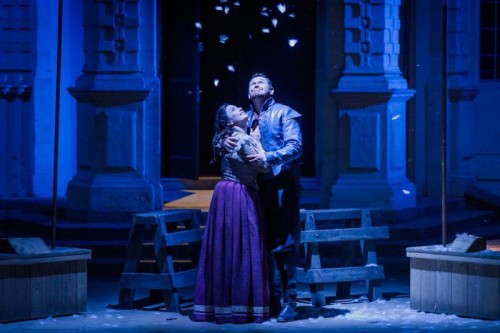 United Kingdom Puccini, La bohème: Soloists, City of London Sinfonia, Opera Holland Park Children’s Chorus and Chorus / Matthew Waldren (conductor), Opera Holland Park, London, 13.6.2016. (RB)
United Kingdom Puccini, La bohème: Soloists, City of London Sinfonia, Opera Holland Park Children’s Chorus and Chorus / Matthew Waldren (conductor), Opera Holland Park, London, 13.6.2016. (RB)

Cast:
Mimì: Anna Patalong
Rodolfo: Shaun Dixon
Marcello: Andrew Finden
Musetta: Elin Pritchard
Schaunard: Frederick Long
Colline: John Savournin
Benoit: David Woloszko
Alcindoro: James Harrison
Parpignol: Michael Bradley
Production:
Director: Stephen Barlow
Designer: Andrew D Edwards
Lighting Designer: Howard Hudson
Chorus Master: Richard Harker
Puccini based La bohème on a collection of short stories by Henry Murger which describe bohemian life in the Latin Quarter in Paris in the 1830’s. Murger wrote: “Bohemia only exists and is only possible in Paris” but one of the great things about Puccini’s opera is that you can transfer the universal story of love and loss to almost any setting or period of time. Given that this is the 400th anniversary of Shakespeare’s death it was a shrewd move by director, Stephen Barlow, to transfer the action in this production to Elizabethan England.
When the opera opens we see Andrew Finden’s Marcello working on a huge canvas depicting the Biblical drowning of Pharaoh and his army in the Red Sea while Shaun Dixon’s Rodolfo is scribbling away on a parchment. The giant painting formed the backdrop to the action for most of the first act and the staging and costumes created an imposing sense of theatre very much in keeping with a production at Shakespeare’s Globe. The party in the second act was choreographed brilliantly and, as characters mingled around the stage and the audience’s attention was diverted to different groupings, the action had an energetic, dynamic feel. There were elements of theatrical artifice throughout e.g. a roll of coloured cardboard creating the illusion of a fire, paper snowflakes falling from the ceiling and a mock sword fight between Schaunard and Colline in Act IV. The costumes were particularly impressive and looked as if they belonged in a painting by Holbein: the men were wearing doublets, breeches and leather boots and the women elaborate gowns in muted colours. Musetta’s costume in Act II was particularly striking and flamboyant conjuring up the image of an anarchic Fairy Queen.
Anna Patalong and Shaun Dixon both did a terrific job in the principal roles of Mimì and Rodolfo. Patalong’s captured the ardour and fragility of Mimì to perfection. She has a sumptuous, richly coloured voice and she brought out the dark timbres of the vocal line in a striking way. There was some gorgeous shaping of the line in Si mi chiamano Mimi while Act III’s Donde lieta usci was exquisitely tender. Dixon’s portrayal of Rodolfo was complex and varied and the transition from thoughtful and fun loving young man to starry eyed lover was dramatically convincing. He brought a powerful bright tone to the vocal line and he captured the romantic ardour well although the diction was not as clear as it might be at the start and there were occasionally issues of balance with the orchestra. The gorgeous Act I duet O soave fanciulla was well sung although the fires of love did not quite ignite at the beginning and it was therefore not entirely convincing dramatically. However, the subsequent scene in which we watched the silhouettes of Mimì and Rodolfo kissing encircled by the light of the moon was gorgeous. The final scene in which Mimì sang her final farewells to Rodolfo combined intimacy and heartbreak in a raw and compelling way and was particularly affecting.
Among the supporting cast, Elin Pritchard stole the show with a wonderfully shrewish portrayal of the worldly, flirtatious Musetta. She sang the famous Waltz in Act II with ravishing brio investing the famous melody with seductive allure whilst producing electrifying top notes. Andrew Finden portrayal of Marcello was complex and rounded and the singing was exemplary throughout. Finden’s diction was excellent and he produced a focused, well projected sound. John Savournin was first rate in the role of Colline and he gave a dark sonorous rendition of Vecchia zimarra in Act IV. Frederick Long gave a convincing portrayal of Schaunard although his voice perhaps needs to develop more and he was at times drowned out by the orchestra.
Matthew Waldren provided assured direction to the cast, orchestra and chorus throughout. The Chorus entries in the crowd scene in Act II were exceptionally well coordinated and the children in the Chorus delivered their contributions with enormous flair. Waldren and the City of London Sinfonia provided a flexible and richly coloured accompaniment although there were a few balance issues. The final few bars of the opera were particularly impressive as brass and strings created powerful, tragic and portentous sonorities as Rodolfo finally realised he had lost his Mimì.
Overall, this was an imaginative and well executed production which is highly recommended.
Robert Beattie
